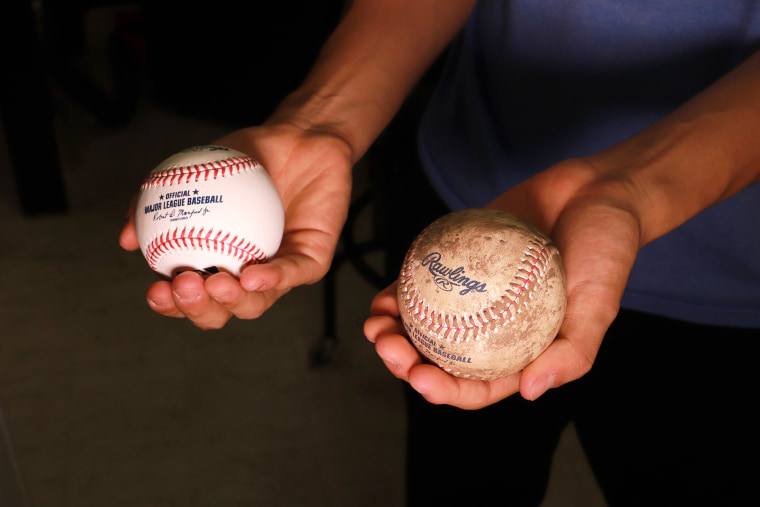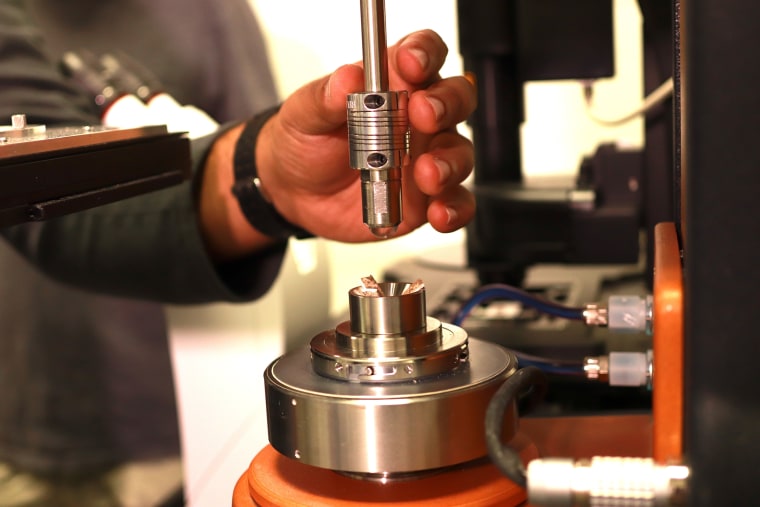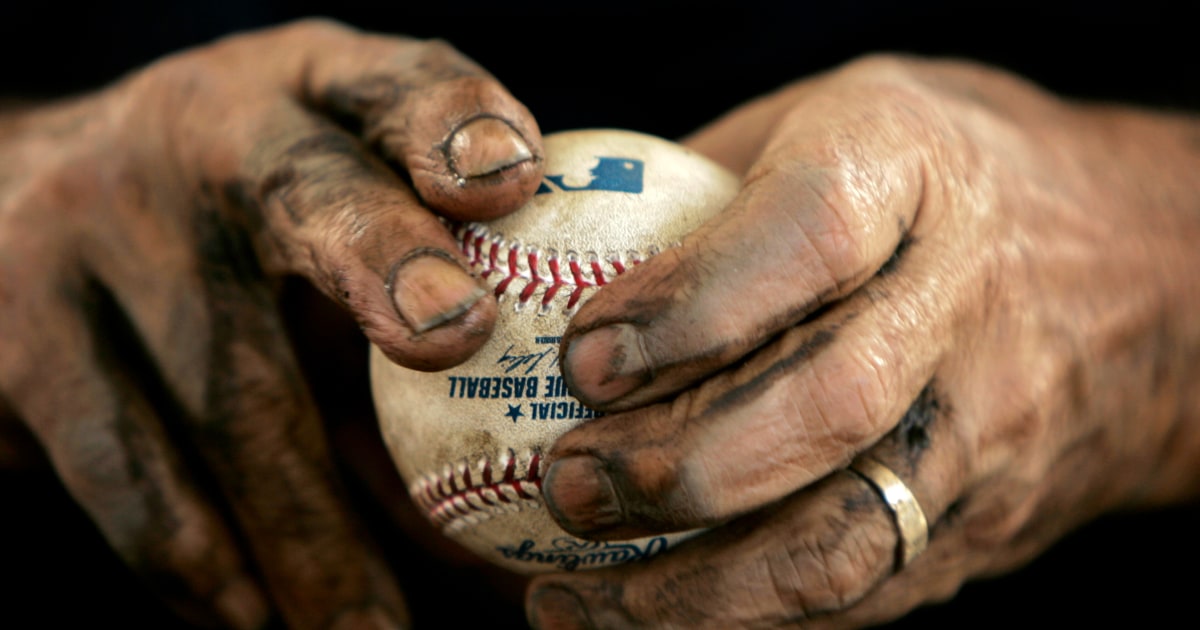Special mud rubbed on MLB baseballs has ‘magical’ properties
The Summary
- For years, a special mud has been rubbed on every baseball before every major league game to make them less slippery.
- The mud’s story dates back to the 1930s, and the MLB still relies on one small supplier.
- A new study explains the science behind why it works: The mud has perfect proportions of clay and sand.
For more than 80 years, baseball has relied on a stash of special mud to take the shine off balls’ slick leather and give fielders a better grip. The substance is rubbed on every baseball before every major league game.
Called Lena Blackburne Baseball Rubbing Mud, it comes from a single source: a secret spot along the banks of a tributary of the Delaware River. Jim Bintliff, a retired New Jersey printing press operator, collects the mud about once a month from his grandfather’s old fishing hole. He likens its consistency, after processing, to a “cold cream or maybe a stiff pudding.”
Despite the mud’s ubiquity, no one had been able to explain the science behind why it makes balls easier to grip — or even provide empirical proof that it worked at all. Until now.
Researchers at the University of Pennsylvania designed a series of tests to study the mud and even constructed a synthetic rubber “finger” to measure its characteristics. Their results, published Monday in the journal Proceedings of the National Academy of Sciences, offer the first published scientific evidence that the mud’s power is more than myth.
“It spreads like face cream, but it grips like sandpaper. It has this magical ability,” said Doug Jerolmack, a geophysicist at the University of Pennsylvania and co-author of the study.

Jerolmack’s team found that the mud has the perfect proportions of sticky clay and particles of sand. The latter studs the surface of a ball like barnacles to enhance friction, yet the material still spreads thin and even, like toothpaste.
“The more you push on it, the more it flows,” Jerolmack said.
The authors concluded that any attempt to create a synthetic substance to replace the mud — something Major League Baseball has explored — would be foolish.
“It is a very special combination of ingredients that nature makes that make it work,” Jerolmack said.
The mud’s origin story is rooted in tragedy.
In a game in August 1920, New York Yankees pitcher Carl Mays fired a ball toward Cleveland shortstop Ray Chapman and hit him in the head. The ball struck Chapman’s skull, killing him.
The death raised concerns about wild pitches and the risk of fresh, shiny baseballs slipping from pitchers’ hands. So in 1929, the president of the National League required umpires to start soiling balls for better grip, according to the Baseball Hall of Fame.
But finding the right substance proved tough.
“They tried to use infield dirt. That scratched the leather too much. They tried using shoe polish and tobacco spit; those things darkened the ball too much,” Bintliff said.
Finally, in 1938, Lena Blackburne, a third-base coach for the Philadelphia Athletics, remembered a fine filtered mud from his childhood in New Jersey. He went back to the source, collected it and began applying it.

The mud was so popular that Blackburne created a business of processing and selling it. Eventually, he passed the company to a childhood friend with whom he used to fish and swim, whose grandson, Bintliff, now runs the company with his wife.
Since 2022, the MLB has mandated that at least 156 balls get prepared for every game, each getting at least a 30-second rub with the mud within a three-hour period.
Bintliff said the MLB purchases tubs of mud for every team at $100 each — two for the regular season and more for spring training. Some clubs, like the World Series-winning Dodgers, purchase additional containers for their farm systems, he added.
“This mud works as a superfine abrasive and takes the gloss coating off without doing any type of damage to the leather or laces,” Bintliff said.
He collects the mud in 5-gallon buckets — usually around 10 to 20 buckets per visit to the riverbank — then processes it in his garage by draining the river water, removing twigs and stone and adding tap water. The process yields a rough average of 150 pounds of product.
Are any special ingredients added?
“That’s the proprietary part,” he said.
The scientists who studied the mud aren’t baseball die-hards, but they got interested after doing an informal analysis of the substance five years ago. After that, two students at Jerolmack’s lab set off to prove whether or not the mud worked. They developed three key tests.

First, they analyzed the mud’s adherence, or stickiness, by using an atomic force microscope, which measures the mud’s resisting force as an instrument pulls away from it. Then, to understand how well the mud flowed, the researchers placed some on a machine called a rheometer that spun the sample and measured its viscosity.
The third test estimated the friction between human skin and a baseball; it involved constructing a “finger” out of synthetic rubber, with a drop of whale oil substituting for the oils secreted by human skin. The “finger” was pressed to strips of leather baseballs then spun on the rheometer.

The properties those tests revealed are rare and sought after in cosmetics and other fields, according to Emanuela Del Gado, director of Georgetown University’s Institute for Soft Matter Synthesis and Metrology.
“In industry, people spend quite some time to adjust the formulation to obtain that type of property,” said Del Gado, who was not involved in the research.
“Simple materials to us, can be extremely complex, and they can teach us a lot,” she added, noting that the mud was shaped by currents, rainfall and long cycles of seasonal environmental changes.
These days, Bintliff counts among his clients college coaches, Little League umpires and National Football League teams. He plans to pass the business to one of his children.
So far, the mud has survived new technology vying to replace it.
In 2016, the MLB tested balls coated with a proprietary chemical, and last year, Commissioner Rob Manfred said the league was working with Dow Chemical to develop a “tacky ball” that would stay “pure white.” But that project has not closed in on a solution that could replace the mud, an MLB source said.
The study authors recommended against abandoning the mud, given their new evidence supporting what ballplayers intuited more than 80 years ago: “This stuff works,” Jerolmack said.

